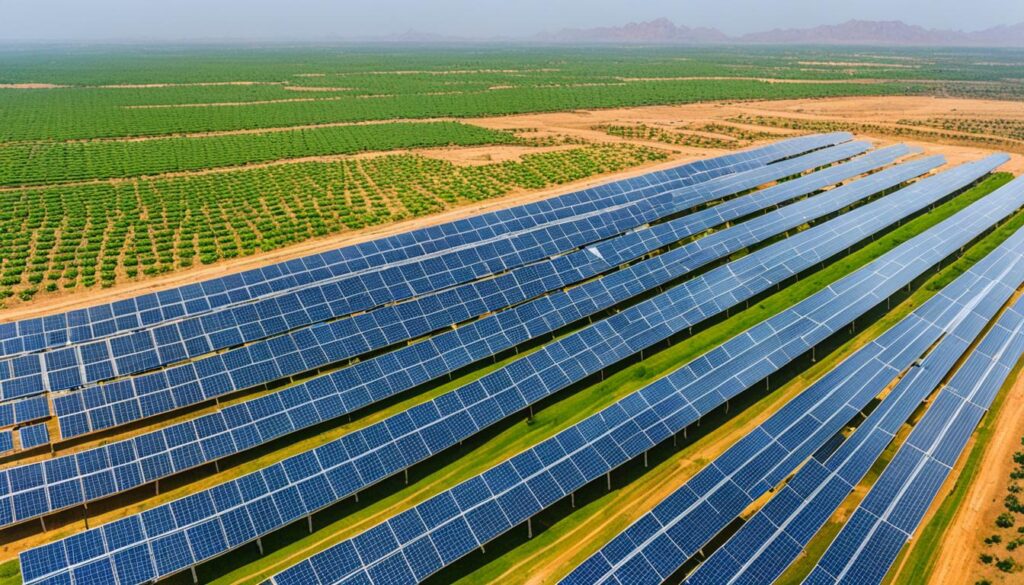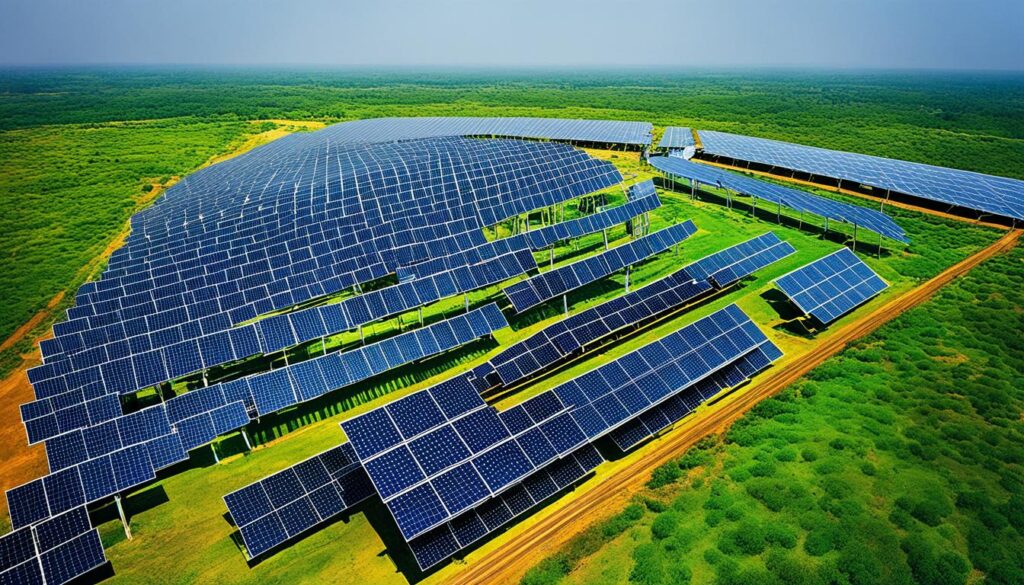India has made big steps in Development of Renewable Energy in India , boosting its sustainable energy efforts and green tech. The country is investing a lot in renewable projects. This puts India among the top in cutting down carbon emissions and promoting eco-friendly actions.
India’s renewable energy capacity has grown a lot thanks to government support, rules, and the private sector. The country is working hard to meet its renewable energy goals. It’s doing this through many projects in solar, wind power generation, and new energy sources. These projects show India’s key role in moving to sustainable energy and its effect on the world’s clean energy scene.
Key Takeaways
- India is a global leader in renewable energy development, significantly investing in sustainable energy initiatives.
- Green technology advancements have enabled India’s substantial increase in renewable energy capacity.
- Clean energy solutions are driving the nation’s efforts to reduce carbon emissions and environmental impact.
- Government policies on renewable energy and private sector investments play a crucial role in renewable energy projects.
- Solar and wind energy projects are at the forefront of India’s renewable energy landscape.
- India’s commitment to green technology sets a benchmark for sustainable development worldwide.
Government Policies and Initiatives
India is on a big mission to use more renewable energy. Government policies have made this possible. They aim to cut down on carbon emissions and help the planet.
Overview of National Policies
The Jawaharlal Nehru National Solar Mission (JNNSM) is a key policy in India’s renewable energy journey. It started in 2010 and focuses on growing solar energy. The goal is to make India a leader in solar energy by 2022, aiming for 100 GW of solar power.
India also plans to reach 175 GW of renewable energy by 2022. This includes wind, solar, and hydroelectric power. These plans show the government’s strong support for renewable energy.

State-Level Initiatives
States like Gujarat, Tamil Nadu, and Rajasthan have their own plans to boost renewable energy. For example, Gujarat and Rajasthan have solar policies. These policies offer incentives and make it easier to invest in solar energy.
“With state-level initiatives, the growth in renewable energy sources has been remarkable. Collaborative efforts between the central and state governments have driven significant advancements in the renewable sector.” — Ministry of New and Renewable Energy (MNRE)
Impact of Subsidies and Incentives
Subsidies and incentives have greatly helped India’s renewable energy sector. The government offers subsidies, tax breaks, and low-interest loans. These have made renewable energy projects cheaper and more attractive.
Thanks to these incentives, there’s been a big increase in investments in renewable energy. For example, a tax benefit for wind power projects has led to more wind energy projects.
Overall, government policies and subsidies have made it easier for renewable energy to grow. This ensures a sustainable and green future for India.
Development Of Renewable Energy In India
India is making big strides in renewable energy, leading to a greener future. This section looks at how renewable energy projects are growing and spreading out.
Solar Energy Projects
Solar energy projects in India are growing fast. They set up big solar parks across the country to use the sun’s power well. The Bhadla Solar Park in Rajasthan is one of the biggest in the world, showing how big these projects are.
More people and businesses are using solar panels too. The PM-KUSUM scheme is helping to spread solar energy, especially in rural areas.
Wind Power Generation
India is also boosting its wind power, thanks to strong winds in coastal areas. States like Tamil Nadu, Gujarat, and Karnataka are leading in wind energy. They have some of the biggest wind farms.
The Muppandal Wind Farm in Tamil Nadu is a key project. It shows India’s effort to use wind energy. These projects help the national grid and create jobs and improve local areas.
Emerging Renewable Energy Sources
India is also looking into other renewable energy sources. Biomass, small hydro, and geothermal energy are becoming important. Biomass uses waste and organic stuff to help rural areas get electricity and manage waste better.
Small hydro projects use mountains to make electricity without harming the environment. Geothermal energy is new but could be a steady and reliable source of power.
Improving technology is key to making these new energy sources better and more useful. With ongoing innovation and investment, India’s renewable energy future looks bright and important for a sustainable world.
Conclusion
India is making big strides in renewable energy, showing its dedication to a green future. The government’s smart policies and efforts have put India at the top of the renewable energy game worldwide. With lots of solar and wind power projects, India shows that clean energy works well.
The government has brought in policies and offered big support with subsidies and incentives. This has helped renewable energy grow fast in India. It has made a great place for investors and innovators. Now, new sources like bioenergy and hydropower are also becoming important.
The future looks bright for India’s renewable energy, but there are still hurdles to cross. We need more innovation, support from policies, and better infrastructure. Sticking to our goals of protecting the environment and being energy independent is key. This way, India can keep leading in renewable energy and work towards a cleaner, greener world.
FAQ
What initiatives are included in India’s development of renewable energy?
India is working on sustainable energy projects and green technology. They’re also focusing on clean energy solutions. This includes big solar projects, wind power, and other new energy sources.
How has the Indian government supported renewable energy growth?
The government has backed renewable energy with policies and programs. They have the Jawaharlal Nehru National Solar Mission and state-level efforts. They also offer subsidies and tax breaks for investing in renewable energy.
These steps help increase the use of renewable energy and cut down on carbon emissions.
What progress has India made in solar energy projects?
India has made big strides in solar energy. They’re building large solar parks and installing more solar panels. This has greatly increased solar energy production, making India a leader in solar energy.
What advancements have been made in wind power generation in India?
India has made big improvements in wind power, using its strong wind resources. They’ve set up big wind farms and are growing their wind energy capacity. This adds to the country’s renewable energy mix.
Are there other emerging renewable energy sources being explored in India?
Yes, India is looking into new renewable energy sources like biomass, small hydro, and geothermal energy. These sources help make the energy mix more diverse and reduce fossil fuel use.
What role do government policies play in India’s renewable energy sector?
Government policies are key in India’s renewable energy sector. They offer support and a framework for renewable energy growth. This includes financial help, regulatory support, and initiatives at the national and state levels.
These policies encourage investment and tech growth in renewable energy.
How does India’s renewable energy growth compare with global standards?
India’s renewable energy growth is impressive globally. The country has boosted its renewable energy capacity a lot. It keeps investing in green tech and sustainable energy projects.
India’s work is recognized worldwide, showing its leadership in moving to clean energy solutions.

